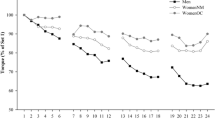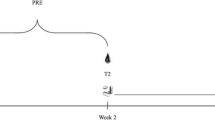Abstract
This study aimed to determine the role of DHEA-S in coping against the exercise training mixing aerobic and resistance components. During 5-day successive exercise training, 16 young male participants (19.2 ± 1.2 years) received either a placebo (flour capsule) or DHEA (100 mg/day) in a double-blinded and placebo-controlled design. Oral DHEA supplementation significantly increased circulating DHEA-S by 2.5-fold, but a protracted drop (~35 %) was observed from Day 3 during training. In the Placebo group, only a minimal DHEA-S reduction (~17 %) was observed. Changes in testosterone followed a similar pattern as DHEA-S. Muscle soreness was elevated significantly on Day 2 for both groups to a similar extent. Lower muscle soreness was observed in the DHEA-supplemented group on Day 3 and Day 6. In the Placebo group, training increased circulating creatine kinase (CK) levels by approximately ninefold, while only a threefold increase was observed in the DHEA-supplemented group. This mix-type exercise training improved glucose tolerance in both groups, while lowering the insulin response to the glucose challenge, but no difference between treatments was observed. Our results suggest that DHEA-S may play a role in protecting skeletal muscle from exercise training-induced muscle damage.





Similar content being viewed by others
References
Aoi W, Naito Y, Takanami Y, Kawai Y, Sakuma K, Ichikawa H, Yoshida N, Yoshikawa T (2004) Oxidative stress and delayed-onset muscle damage after exercise. Free Radic Biol Med 37:480–487
Aragno M, Parola S, Brignardello E, Mauro A, Tamagno E, Manti R, Danni O, Boccuzzi G (2000) Dehydroepiandrosterone prevents oxidative injury induced by transient ischemia/reperfusion in the brain of diabetic rats. Diabetes 49:1924–1931
Ashton W, Degnan B, Daniel A, Francis G (1995) Testosterone increases insulin-like growth factor-1 and insulin-like growth factor-binding protein. Ann Clin Lab Sci 25:381–388
Asp S, Rohde T, Richter EA (1997) Impaired muscle glycogen resynthesis after a marathon is not caused by decreased muscle GLUT-4 content. J Appl Physiol 83:1482–1485
Bastianetto S, Ramassamy C, Poirier J, Quirion R (1999) Dehydroepiandrosterone (DHEA) protects hippocampal cells from oxidative stress-induced damage. Brain Res Mol Brain Res 66:35–41
Bouchard C, Tremblay A, Leblanc C, Lortie G, Savard R, Theriault G (1983) A method to assess energy expenditure in children and adults. Am J Clin Nutr 37:461–467
Brignardello E, Runzo C, Aragno M, Catalano MG, Cassader M, Perin PC, Boccuzzi G (2007) Dehydroepiandrosterone administration counteracts oxidative imbalance and advanced glycation end product formation in type 2 diabetic patients. Diabetes Care 30:2922–2927
Byrnes WC, Clarkson PM, White JS, Hsieh SS, Frykman PN, Maughan RJ (1985) Delayed onset muscle soreness following repeated bouts of downhill running. J Appl Physiol 59:710–715
Ceci R, Duranti G, Rossi A, Savini I, Sabatini S (2011) Skeletal muscle differentiation: role of dehydroepiandrosterone sulfate. Horm Metab Res 43:702–707
Clarkson P, Nosaka K, Braun B (1992) Muscle function after exercise-induced muscle damage and rapid adaptation. Med Sci Sports Exerc 24:512–520
Corrigan B (2002) DHEA and sport. Clin J Sport Med 12:236–241
Costill DL, Pascoe DD, Fink WJ, Robergs RA, Barr SI, Pearson D (1990) Impaired muscle glycogen resynthesis after eccentric exercise. J Appl Physiol 69:46–50
Cumming D, Brunsting L, Strich G, Ries A, Rebar R (1986) Reproductive hormone increases in response to acute exercise in men. Med Sci Sports Exerc 18:369–373
Davis JM, Murphy EA, Carmichael MD, Zielinski MR, Groschwitz CM, Brown AS, Gangemi JD, Ghaffar A, Mayer EP (2007) Curcumin effects on inflammation and performance recovery following eccentric exercise-induced muscle damage. Am J Physiol Regul Integr Comp Physiol 292:R2168–R2173
Diamond P, Brisson G, Candas B, Peronnet F (1989) Trait anxiety, submaximal physical exercise and blood androgens. Eur J Appl Physiol Occup Physiol 58:699–704
Evans WJ (2000) Vitamin E, vitamin C, and exercise. Am J Clin Nutr 72:647S–652S
Flann KL, LaStayo PC, McClain DA, Hazel M, Lindstedt SL (2011) Muscle damage and muscle remodeling: no pain, no gain? J Exp Biol 214:674–679
Fluckey JD, Vary TC, Jefferson LS, Evans WJ, Farrell PA (1996) Insulin stimulation of protein synthesis in rat skeletal muscle following resistance exercise is maintained with advancing age. J Gerontol A Biol Sci Med Sci 51A:B323–B330
Fluckey JD, Knox M, Smith L, Dupont-Versteegden EE, Gaddy D, Tesch PA, Peterson CA (2006) Insulin-facilitated increase of muscle protein synthesis after resistance exercise involves a MAP kinase pathway. Am J Physiol Endocrinol Metab 290:E1205–E1211
Gant N, Hutchinson H, Siiteri P, MacDonald P (1971) Study of the metabolic clearance rate of dehydroisoandrosterone sulfate in pregnancy. Am J Obstet Gynecol 111:555–563
Hackney AC, Sharp RL, Runyan WS, Ness RJ (1989) Relationship of resting prolactin and testosterone in males during intensive training. Br J Sports Med 23:194
Hardin D, Azzarelli B, Edwards J, Wigglesworth J, Maianu L, Brechtel G, Johnson A, Baron A, Garvey W (1995) Mechanisms of enhanced insulin sensitivity in endurance-trained athletes: effects on blood flow and differential expression of GLUT 4 in skeletal muscles. J Clin Endocrinol Metab 80:2437–2446
Holloszy JO (2005) Exercise-induced increase in muscle insulin sensitivity. J Appl Physiol 99:338–343
Ivy J, Kuo C (1998) Regulation of GLUT4 protein and glycogen synthase during muscle glycogen synthesis after exercise. Acta Physiol Scand 162:295–304
Jakubowicz D, Beer N, Rengifo R (1995) Effect of dehydroepiandrosterone on cyclic-guanosine monophosphate in men of advancing age. Ann N Y Acad Sci 774:312–315
Kimura M, Tanaka S-i, Yamada Y, Kiuchi Y, Yamakawa T, Sekihara H (1998) Dehydroepiandrosterone decreases serum tumor necrosis factor-{alpha} and restores insulin sensitivity: independent effect from secondary weight reduction in genetically obese Zucker fatty rats. Endocrinology 139:3249–3253
Kraemer WJ, Ratamess NA (2005) Hormonal responses and adaptations to resistance exercise and training. Sports Med 35:339–361
Kraemer WJ, Fragala MS, Watson G, Volek JS, Rubin MR, French DN, Maresh CM, Vingren JL, Hatfield DL, Spiering BA, Ho JY, Hughes SL, Case HS, Stuempfle KJ, Lehmann DR, Bailey S, Evans DS (2008) Hormonal responses to a 160-km race across frozen Alaska. Br J Sports Med 42:116–120
Kroboth P, Salek F, Pittenger A, Fabian T, Frye R (1999) DHEA and DHEA-S: a review. J Clin Pharmacol 39:327–348
Lai Y, Chen C, Kuo C (2009) Exercise and type 2 diabetes. Adaptive Med 1:1–16
Lane MA, Ingram DK, Ball SS, Roth GS (1997) Dehydroepiandrosterone sulfate: a biomarker of primate aging slowed by calorie restriction. J Clin Endocrinol Metab 82:2093–2096
Lee W, Chen S, Wu M, Hou C, Lai Y, Laio Y, Lin C, Kuo C (2006) The role of dehydroepiandrosterone levels on physiologic acclimatization to chronic mountaineering activity. High Alt Med Biol 7:228–236
Liu T, Kuo C, Wang P (2009) Exercise and testosterone. Adaptive Med 1:24–29
Luppa P, Munker R, Nagel D, Weber M, Engelhardt D (1991) Serum androgens in intensive-care patients: correlations with clinical findings. Clin Endocrinol (Oxf) 34:305–310
MacIntyre D, Reid W, McKenzie D (1995) Delayed muscle soreness. The inflammatory response to muscle injury and its clinical implications. Sports Med 20:24–40
Miller W, Sherman W, Ivy J (1984) Effect of strength training on glucose tolerance and post-glucose insulin response. Med Sci Sports Exerc 16:539–543
Morales A, Nolan J, Nelson J, Yen S (1994) Effects of replacement dose of dehydroepiandrosterone in men and women of advancing age [published erratum appears in J Clin Endocrinol Metab 1995;80(9):2799]. J Clin Endocrinol Metab 78:1360–1367
Morgan C, Wang S, Mason J, Southwick S, Fox P, Hazlett G, Charney D, Greenfield G (2000) Hormone profiles in humans experiencing military survival training. Biol Psychiatry 47:891–901
Olech E, Merrill JT (2005) DHEA supplementation: the claims in perspective. Cleve Clin J Med 72:965–966
Proske U (2005) Muscle tenderness from exercise: mechanisms? J Physiol 564:1
Roth GS, Lane MA, Ingram DK, Mattison JA, Elahi D, Tobin JD, Muller D, Metter EJ (2002) Biomarkers of caloric restriction may predict longevity in humans. Science 297:811
Schafers M, Sorkin L, Sommer C (2003) Intramuscular injection of tumor necrosis factor-alpha induces muscle hyperalgesia in rats. Pain 104:579–588
Straub RH, Konecna L, Hrach S, Rothe G, Kreutz M, Scholmerich J, Falk W, Lang B (1998) Serum dehydroepiandrosterone (DHEA) and DHEA sulfate are negatively correlated with serum interleukin-6 (IL-6), and DHEA inhibits IL-6 secretion from mononuclear cells in man in vitro: possible link between endocrinosenescence and immunosenescence. J Clin Endocrinol Metab 83:2012–2017
Suzuki M, Wright LS, Marwah P, Lardy HA, Svendsen CN (2004) Mitotic and neurogenic effects of dehydroepiandrosterone (DHEA) on human neural stem cell cultures derived from the fetal cortex. Proc Natl Acad Sci USA 101:3202–3207
Thompson D, Nicholas C, Williams C (1999) Muscular soreness following prolonged intermittent high-intensity shuttle running. J Sports Sci 17:387–395
Tsai Y, Chou S, Lin Y, Hou C, Hung K, Kung H, Lin T, Chen S, Lin C, Kuo C (2006) Effect of resistance exercise on dehydroepiandrosterone sulfate concentrations during a 72-h recovery: relation to glucose tolerance and insulin response. Life Sci 79:1281–1286
Twist C, Eston R (2005) The effects of exercise-induced muscle damage on maximal intensity intermittent exercise performance. Eur J Appl Physiol 94:652–658
Vasankari TJ, Kujala UM, Heinonen OJ, Huhtaniemi IT (1993) Effects of endurance training on hormonal responses to prolonged physical exercise in males. Acta Endocrinol 129:109–113
Wang J, Chen S, Lee S, Lee S, Huang C, Hsieh C, Kuo C (2009) Dehydroepiandrosterone sulfate linked to physiologic response against hot spring immersion. Steroids 74:945–949
Williams MRI, Dawood T, Ling S, Dai A, Lew R, Myles K, Funder JW, Sudhir K, Komesaroff PA (2004) Dehydroepiandrosterone increases endothelial cell proliferation in vitro and improves endothelial function in vivo by mechanisms independent of androgen and estrogen receptors. J Clin Endocrinol Metab 89:4708–4715
Yang S, Chen C, Liao Y, Lin F, Lee W, Cho Y, Chen M, Chous C, Kuo C (2005) Interactive effect of an acute bout of resistance exercise and dehydroepiandrosterone administration on glucose tolerance and serum lipids in middle-aged women. Chin J Physiol 48:23–29
Zeviani M (2008) Train, train, train! No pain, just gain. Brain 131:2809–2811
Acknowledgments
This study is supported in part by Taiwan Department of Health Clinical Trial and Research Center of Excellence (DOH100-TD-B-111-004). We appreciated all the subjects participating in this study.
Conflict of interest
The authors declare no conflict of interests.
Author information
Authors and Affiliations
Corresponding author
Additional information
Communicated by William J. Kraemer.
S.-D. Lee and C.-H. Kuo are equally contributed to this work.
Rights and permissions
About this article
Cite this article
Liao, YH., Liao, KF., Kao, CL. et al. Effect of dehydroepiandrosterone administration on recovery from mix-type exercise training-induced muscle damage. Eur J Appl Physiol 113, 99–107 (2013). https://doi.org/10.1007/s00421-012-2409-6
Received:
Accepted:
Published:
Issue Date:
DOI: https://doi.org/10.1007/s00421-012-2409-6




